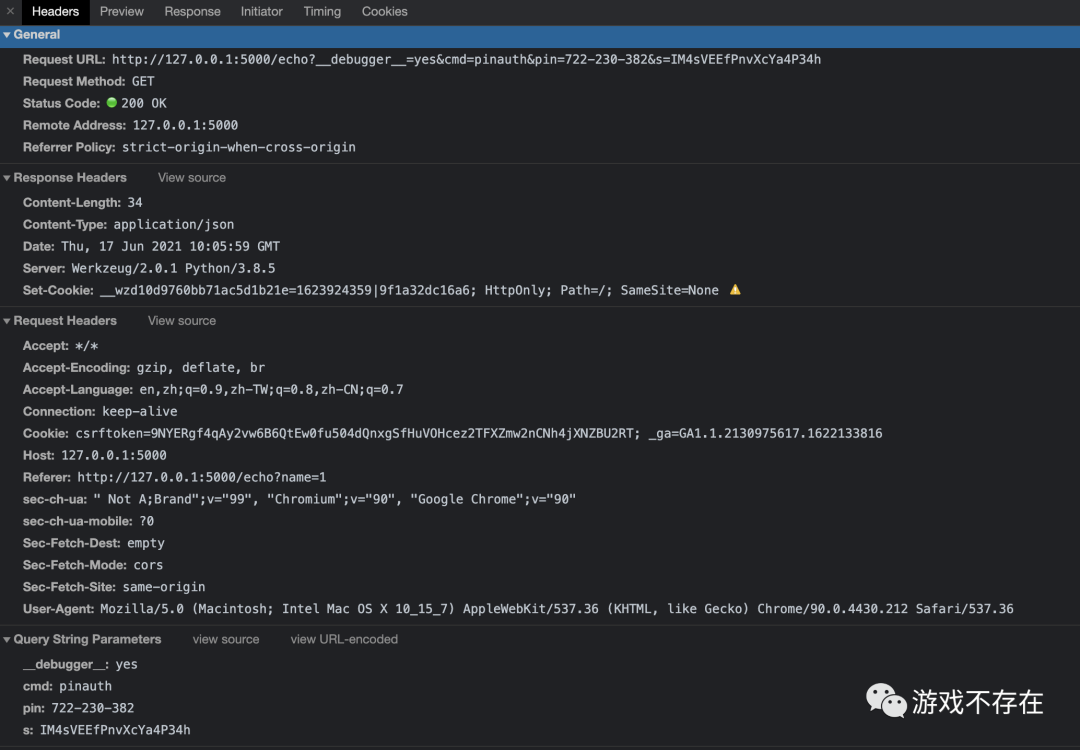werkzeug源码阅读-完结篇
Werkzeug是一个全面的WSGI Web应用程序库。它最初是WSGI实用程序各种工具的简单集合,现已成为最高级的WSGI实用程序库之一,是Flask背后的项目。Werkzeug 是一个德语单词,工具的意思。这个单词发音对我来说,有点困难(可能也是它知名度不高的重要因素之一),刚好官方logo是个锤子,我就简称“德国锤子”。文章已经完成上下两篇,上篇介绍:
- serving && wsgi
- request && response
- local的
下篇介绍:
- middleware
- routing && urls
- datastructures
“德国锤子” 还有3个比较重要的功能,不要放过,我们继续学习:
- reloader
- debug
- 配合SQLAlchemy操作数据库
reloader
reloader演示
reloader是调试程序时非常实用的功能,开发的时候不用手动重启服务,修改代码后会自动重启服务,提高研发效率。运行示例中的Shorty服务:
# python3 shortly.py
* Running on http://127.0.0.1:5000/ (Press CTRL+C to quit)
* Restarting with stat
* Debugger is active!
* Debugger PIN: 722-230-382程序启动后实际上有2个进程, 10527 的主进程和 10529 的子进程:
501 10527 7144 0 8:36上午 ttys008 0:00.23 .../Python.app/Contents/MacOS/Python shortly.py
501 10529 10527 0 8:36上午 ttys008 0:00.34 .../Python.app/Contents/MacOS/Python /Users/yoo/work/yuanmahui/python/ch20-werkzeug/shortly.py随便修改一下 shortly.py 代码,比如增加一个日志输出。可以发现启动日志有下面reload的信息:
...
* Detected change in '/Users/yoo/work/yuanmahui/python/ch20-werkzeug/shortly.py', reloading
* Restarting with stat
...再观查进程信息可以发现 10529 子进程已经退出,新增了 10634 子进程:
501 10527 7144 0 8:36上午 ttys008 0:00.24 .../Python.app/Contents/MacOS/Python shortly.py
501 10634 10527 0 8:38上午 ttys008 0:00.77 .../Python.app/Contents/MacOS/Python /Users/yoo/work/yuanmahui/python/ch20-werkzeug/shortly.py可以推测,主/子进程检测代码变动,然后子进程关闭/退出,再由主进程重新创建一个子进程。那么到底子进程是自动退出还是被主进程关闭?是主进程监听代码变化还是子进程监听的呢?我们带着这2个问题,一起看看代码实现。
reloader的实现原理
启动服务的时候,需要使用 use_reloader=True 参数启动reloader
run_simple("127.0.0.1", 5000, app, use_debugger=True, use_reloader=True)
服务启动时候判断是独立启动,还是由reload启动:
# serving.py
def run_simple(...):
if not is_running_from_reloader():
...
from ._reloader import run_with_reloader as _rwr
_rwr(
inner,
extra_files=extra_files,
exclude_patterns=exclude_patterns,
interval=reloader_interval,
reloader_type=reloader_type,
)主进程和子进程的判断是通过 WERKZEUG_RUN_MAIN 的环境变量进行判断,默认情况下是没有这个环境变量:
def is_running_from_reloader() -> bool:
return os.environ.get("WERKZEUG_RUN_MAIN") == "true"使用reloader启动的代码如下:
# _reloader.py
def run_with_reloader(
main_func: t.Callable[[], None],
extra_files: t.Optional[t.Iterable[str]] = None,
exclude_patterns: t.Optional[t.Iterable[str]] = None,
interval: t.Union[int, float] = 1,
reloader_type: str = "auto",
) -> None:
"""Run the given function in an independent Python interpreter."""
import signal
signal.signal(signal.SIGTERM, lambda *args: sys.exit(0))
reloader = reloader_loops[reloader_type](
extra_files=extra_files, exclude_patterns=exclude_patterns, interval=interval
)
try:
if os.environ.get("WERKZEUG_RUN_MAIN") == "true":
ensure_echo_on()
t = threading.Thread(target=main_func, args=())
t.daemon = True
# Enter the reloader to set up initial state, then start
# the app thread and reloader update loop.
with reloader:
t.start()
reloader.run()
else:
sys.exit(reloader.restart_with_reloader())
except KeyboardInterrupt:
pass代码主要功能:
- 注册系统信号处理,支持使用 CTRL+C 退出
- 选择reloader的实现,默认是
stat的实现,还有一种是watchdog的实现。后者需要额外安装,但是效率会高一些 - 判断是否主进程,主进程则只是启动reloader ; 子进程则使用守护线程方式启动服务程序
关于stat和watchdog的区别,请看下面的官方文档:
默认stat后端只是mtime定期检查所有文件的 。这对于大多数情况来说已经足够了,但是众所周知,它会耗尽笔记本电脑的电池。
在watchdog后端使用文件系统事件,而且比stat快, 但是它需要 安装看门狗模块。实现此目的的推荐方法是添加 Werkzeug[watchdog]到您的需求文件中。
ReloaderLoop是reloader实现的基类:
class ReloaderLoop:
name = ""
def __init__(
self,
extra_files: t.Optional[t.Iterable[str]] = None,
exclude_patterns: t.Optional[t.Iterable[str]] = None,
# 默认1s的间隔
interval: t.Union[int, float] = 1,
) -> None:
self.extra_files: t.Set[str] = {os.path.abspath(x) for x in extra_files or ()}
self.exclude_patterns: t.Set[str] = set(exclude_patterns or ())
self.interval = interval
def __enter__(self) -> "ReloaderLoop":
"""Do any setup, then run one step of the watch to populate the
initial filesystem state.
"""
self.run_step()
return self
def __exit__(self, exc_type, exc_val, exc_tb): # type: ignore
"""Clean up any resources associated with the reloader."""
pass
def run(self) -> None:
"""Continually run the watch step, sleeping for the configured
interval after each step.
"""
while True:
self.run_step()
time.sleep(self.interval)
def run_step(self) -> None:
"""Run one step for watching the filesystem. Called once to set
up initial state, then repeatedly to update it.
"""
pass
def restart_with_reloader(self) -> int:
"""Spawn a new Python interpreter with the same arguments as the
current one, but running the reloader thread.
"""
while True:
_log("info", f" * Restarting with {self.name}")
args = _get_args_for_reloading()
new_environ = os.environ.copy()
new_environ["WERKZEUG_RUN_MAIN"] = "true"
exit_code = subprocess.call(args, env=new_environ, close_fds=False)
if exit_code != 3:
return exit_code
def trigger_reload(self, filename: str) -> None:
self.log_reload(filename)
sys.exit(3)
def log_reload(self, filename: str) -> None:
filename = os.path.abspath(filename)
_log("info", f" * Detected change in {filename!r}, reloading")- ReloaderLoop是一个上下文装饰器,进入的时候自动调用子类的run_step方法。
- 在主进程中使用restart_with_reloader函数进行工作。这是一个无限循环,循环中使用
subprocess.call创建一个子进程,并监听子进程的退出状态。如果退出状态为3则可以无限循环;如果不为3则会退出循环,结束主进程。 - 创建子进程时候,设置关键的 WERKZEUG_RUN_MAIN 环境变量标识。
- 子进程使用run方法持续监听代码变化。
- 如果触发reload则当前子进程退出。
StatReloaderLoop的实现比较简单,代码如下:
class StatReloaderLoop(ReloaderLoop):
name = "stat"
def __enter__(self) -> ReloaderLoop:
self.mtimes: t.Dict[str, float] = {}
return super().__enter__()
def run_step(self) -> None:
for name in chain(_find_stat_paths(self.extra_files, self.exclude_patterns)):
try:
mtime = os.stat(name).st_mtime
except OSError:
continue
old_time = self.mtimes.get(name)
if old_time is None:
self.mtimes[name] = mtime
continue
if mtime > old_time:
self.trigger_reload(name)- run_step中记录每个代码的时间戳,如果发现有文件的时间戳变化,则调用父类的trigger_reload
所以主进程只是负责持续创建子进程,子进程自己检测代码变化和自动退出。
debug
debug的展示
在Shortly中增加一个echo的view:
Rule("/echo", endpoint="echo"),
def on_echo(self, request):
raise访问这个view可以看到下面的异常信息, 带有完整的业务堆栈:
点击右侧的console图标,会提示输入PIN:
在console中可以进行调试:
2.0.1版本的dubug可能有bug,需要使用os.environ["WERKZEUG_DEBUG_PIN"] = "off"关闭pin-auth的认证,才能够正常工作
debug的实现原理
python3自带REPL的模块 code, 看起来和python的命令行差不多,仔细对比会发现多了 (InteractiveConsole) 的输出。自己的应用程序中嵌入code,就可以实现交互式的debug功能。
# python3 -m code
Python 3.8.5 (v3.8.5:580fbb018f, Jul 20 2020, 12:11:27)
[Clang 6.0 (clang-600.0.57)] on darwin
Type "help", "copyright", "credits" or "license" for more information.
(InteractiveConsole) # <- 提示信息
>>>
# python3
Python 3.8.5 (v3.8.5:580fbb018f, Jul 20 2020, 12:11:27)
[Clang 6.0 (clang-600.0.57)] on darwin
Type "help", "copyright", "credits" or "license" for more information.
>>>启动服务的入口,如果有debug参数则使用DebuggedApplication来包裹业务app:
# serving.py
def run_simple(...):
if use_debugger:
from .debug import DebuggedApplication
application = DebuggedApplication(application, use_evalex)DebuggedApplication主要的call函数:
# debug
def __call__(
self, environ: "WSGIEnvironment", start_response: "StartResponse"
) -> t.Iterable[bytes]:
"""Dispatch the requests."""
request = Request(environ)
response = self.debug_application
if request.args.get("__debugger__") == "yes":
# 处理debug请求
cmd = request.args.get("cmd")
arg = request.args.get("f")
secret = request.args.get("s")
frame = self.frames.get(request.args.get("frm", type=int))
if cmd == "resource" and arg:
response = self.get_resource(request, arg) # type: ignore
elif cmd == "pinauth" and secret == self.secret:
response = self.pin_auth(request) # type: ignore
elif cmd == "printpin" and secret == self.secret:
response = self.log_pin_request() # type: ignore
elif (
self.evalex
and cmd is not None
and frame is not None
and self.secret == secret
and self.check_pin_trust(environ)
):
response = self.execute_command(request, cmd, frame) # type: ignore
elif (
self.evalex
and self.console_path is not None
and request.path == self.console_path
):
response = self.display_console(request) # type: ignore
return response(environ, start_response)- call接收wsgi的输入environ和start_response
- response使用debug_application处理
- 如果request上有__debugger__信息,则进行debug处理,比如显示异常堆栈,显示PIN认证以及调试指令等等
debug的重点在debug_application函数:
def debug_application(
self, environ: "WSGIEnvironment", start_response: "StartResponse"
) -> t.Iterator[bytes]:
"""Run the application and conserve the traceback frames."""
app_iter = None
try:
# 正常业务
app_iter = self.app(environ, start_response)
yield from app_iter
if hasattr(app_iter, "close"):
app_iter.close() # type: ignore
except Exception:
# 异常调试
if hasattr(app_iter, "close"):
app_iter.close() # type: ignore
traceback = get_current_traceback(
skip=1,
show_hidden_frames=self.show_hidden_frames,
ignore_system_exceptions=True,
)
for frame in traceback.frames:
self.frames[frame.id] = frame
self.tracebacks[traceback.id] = traceback
try:
start_response(
"500 INTERNAL SERVER ERROR",
[
("Content-Type", "text/html; charset=utf-8"),
("X-XSS-Protection", "0"),
],
)
except Exception:
environ["wsgi.errors"].write(
"Debugging middleware caught exception in streamed "
"response at a point where response headers were already "
"sent.\n"
)
else:
is_trusted = bool(self.check_pin_trust(environ))
yield traceback.render_full(
evalex=self.evalex, evalex_trusted=is_trusted, secret=self.secret
).encode("utf-8", "replace")
traceback.log(environ["wsgi.errors"])- 使用
app_iter = self.app(environ, start_response)执行业务功能 - 使用try-except捕获业务异常,对异常信息进行获取traceback
- 返回500的http状态,并且使用traceback.render_full渲染html显示异常堆栈
pin
debug可以使用web界面调试程序,这会产生安全问题。所以werkzeug的debug中引入了PIN机制,需要输入PIN验证码才可以进行调试,PIN在服务端的命令行中输出。
前端页面输入PIN后会提交PIN码:
# debugger.js
function initPinBox() {
document.querySelector(".pin-prompt form").addEventListener(
"submit",
function (event) {
....
fetch(
`${document.location.pathname}?__debugger__=yes&cmd=pinauth&pin=${pin}&s=${encodedSecret}`
)
.then((res) => res.json())
.then(({auth, exhausted}) => {
if (auth) {
EVALEX_TRUSTED = true;
fadeOut(document.getElementsByClassName("pin-prompt")[0]);
} else {
....
}
})
...
},
false
);
}这段JS代码重点是 __debugger__=yes&cmd=pinauth&pin=${pin}&s=${encodedSecret} 的URL,这个请求会直接被DebuggedApplication处理:
if request.args.get("__debugger__") == "yes":
cmd = request.args.get("cmd")
arg = request.args.get("f")
secret = request.args.get("s")
frame = self.frames.get(request.args.get("frm", type=int)) # type: ignore
...
elif cmd == "pinauth" and secret == self.secret:
response = self.pin_auth(request) # type: ignore
...
elif (
self.evalex
and cmd is not None
and frame is not None
and self.secret == secret
and self.check_pin_trust(environ)
):
response = self.execute_command(request, cmd, frame) # type: ignore- 如果cmd=pinauth则进行pin的验证
- 如果cmd是其它,比如dump或者对象之类,则执行对应的command, 调试信息的时候会使用
auth认证函数:
def pin_auth(self, request: Request) -> Response:
"""Authenticates with the pin."""
exhausted = False
auth = False
trust = self.check_pin_trust(request.environ)
...
# Otherwise go through pin based authentication
else:
entered_pin = request.args["pin"]
# 对比PIN
if entered_pin.strip().replace("-", "") == pin.replace("-", ""):
self._failed_pin_auth = 0
auth = True
else:
self._fail_pin_auth()
rv = Response(
json.dumps({"auth": auth, "exhausted": exhausted}),
mimetype="application/json",
)
if auth:
# 设置cookie
rv.set_cookie(
self.pin_cookie_name,
f"{int(time.time())}|{hash_pin(pin)}",
httponly=True,
samesite="None",
)
elif bad_cookie:
rv.delete_cookie(self.pin_cookie_name)
return rv查看http请求详情,会发现认证成功后会设置一个Response-Cookie:__wzd10d9760bb71ac5d1b21e ,这样后续的debug调试都使用这个cookie。
开启PIN验证后,无法调试就是因为这个cookie在调试的时候没有附带上
Interactive
debug调试主要使用_InteractiveConsole的runsource实现:
class _InteractiveConsole(code.InteractiveInterpreter):
locals: t.Dict[str, t.Any]
...
def runsource(self, source: str, **kwargs: t.Any) -> str: # type: ignore
source = f"{source.rstrip()}\n"
ThreadedStream.push()
prompt = "... " if self.more else ">>> "
try:
source_to_eval = "".join(self.buffer + [source])
if super().runsource(source_to_eval, "<debugger>", "single"):
self.more = True
self.buffer.append(source)
else:
self.more = False
del self.buffer[:]
finally:
output = ThreadedStream.fetch()
return prompt + escape(source) + output
...runsource函数比较复杂,但是核心就是对前端网页提交的字符串信息进行编译执行,并把执行的输出捕获后反馈给前端,和之前的介绍CGI实现类似。
开发的时候,可以利用debug功能协助进行调试,提高研发效率。需要注意的是,debug功能不可以用于线上环境。
配合SQLAlchemy操作数据库
数据库操作是Web程序非常重要的一环,werkzeug中操作数据可以使用sqlalchemy。
SQLAlchemy回顾
在正式介绍Werkzeug配合SQLAlchemy操作数据库操作数据库之前,我们先简单回顾一下SQLAlchemy的ORM使用:
from sqlalchemy import create_engine
from sqlalchemy.ext.declarative import declarative_base
from sqlalchemy import Column, Integer, String
from sqlalchemy.orm import sessionmaker
engine = create_engine('sqlite:///:memory:', echo=True)
Model = declarative_base()
class User(Model):
__tablename__ = 'users'
id = Column(Integer, primary_key=True)
name = Column(String)
fullname = Column(String)
nickname = Column(String)
def __repr__(self):
return "<User(name='%s', fullname='%s', nickname='%s')>" % (
self.name, self.fullname, self.nickname)
Model.metadata.create_all(engine)
print("=" * 10)
Session = sessionmaker(bind=engine)
session = Session()
ed_user = User(name='ed', fullname='Ed Jones', nickname='edsnickname')
session.add(ed_user)
session.commit()
print(ed_user.id)
result = engine.execute("select * from users")
for row in result:
print(row)- 创建engine,用于数据库连接
- 创建Model
- 创建User模型
- 将metadata提交到engine(创建表)
- 创建session
- 使用users插入数据:创建对象,add到session,然后提交session
- ...
SQLAlchemy配合使用
示例shorty中演示了如何使用SQLAlchemy操作SQLite数据库。使用方法是先使用 initdb 初始化sqlite数据库,然后再使用 runserver 启动服务:
python3 manage-shorty.py initdb
python3 manage-shorty.py runserver先看看View中如何通过ORM操作数据,这是插入数据:
uid = URL(url, "private" not in request.form, alias).uid
session.commit()这是查询数据:
url = URL.query.get(uid)
- 创建数据后使用session.commit后就提交
- 查询数据使用模型的query
URL的数据模型是这样定义的:
url_table = Table(
"urls",
metadata,
Column("uid", String(140), primary_key=True),
Column("target", String(500)),
Column("added", DateTime),
Column("public", Boolean),
)
class URL:
query = session.query_property()
def __init__(self, target, public=True, uid=None, added=None):
self.target = target
self.public = public
self.added = added or datetime.utcnow()
if not uid:
while 1:
uid = get_random_uid()
if not URL.query.get(uid):
break
self.uid = uid
session.add(self)
@property
def short_url(self):
return url_for("link", uid=self.uid, _external=True)
def __repr__(self):
return f"<URL {self.uid!r}>"
mapper(URL, url_table)- 注意URL模型的init方法,创建对象时候自动生成uid,并且添加到session,然后view使用commit就提交数据。这种使用方式和回顾里一致。
- URL中定义了一个query,可以用来检索数据,这和django中Model的object类似。
database_engine在创建创建App时候创建:
class Shorty:
def __init__(self, db_uri):
local.application = self
self.database_engine = create_engine(db_uri, convert_unicode=True)
self.dispatch = SharedDataMiddleware(self.dispatch, {"/static": STATIC_PATH})
def init_database(self):
# 等同 Model.metadata.create_all(engine)
metadata.create_all(self.database_engine)最关键的地方是session:
local = Local()
local_manager = LocalManager([local])
# local.application = self
application = local("application")
...
session = scoped_session(
lambda: create_session(
application.database_engine, autocommit=False, autoflush=False
)
)简单的说这里scoped_session是绑定到线程的,跟随请求的生命周期。这样在请求中可以使用session访问数据。
小结
本章我们学习了web框架如何使用reload和debug协助研发,提高研发效率。reload主要是使用了subprocess开启多个python进程,debug则是使用code的REPL功能。
werkzeug也提供了使用sqlalchemy操作数据库的示例Shorty,使用ORM功能可以快速编写适配多种数据存储引擎的程序。
参考链接
- Contextual/Thread-local Sessions https://docs.sqlalchemy.org/en/13/orm/contextual.html
- https://stackoverflow.com/questions/6519546/scoped-sessionsessionmaker-or-plain-sessionmaker-in-sqlalchemy



